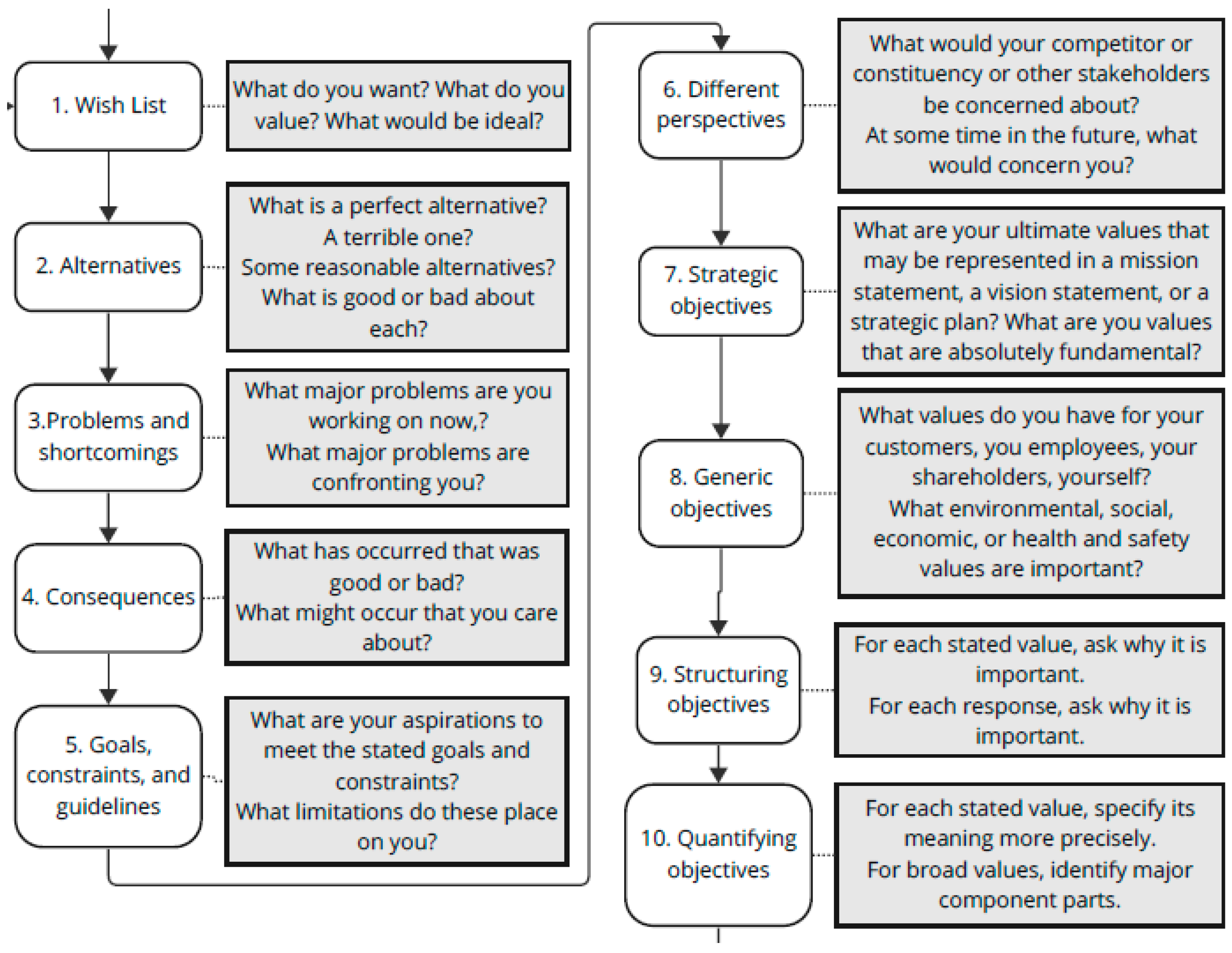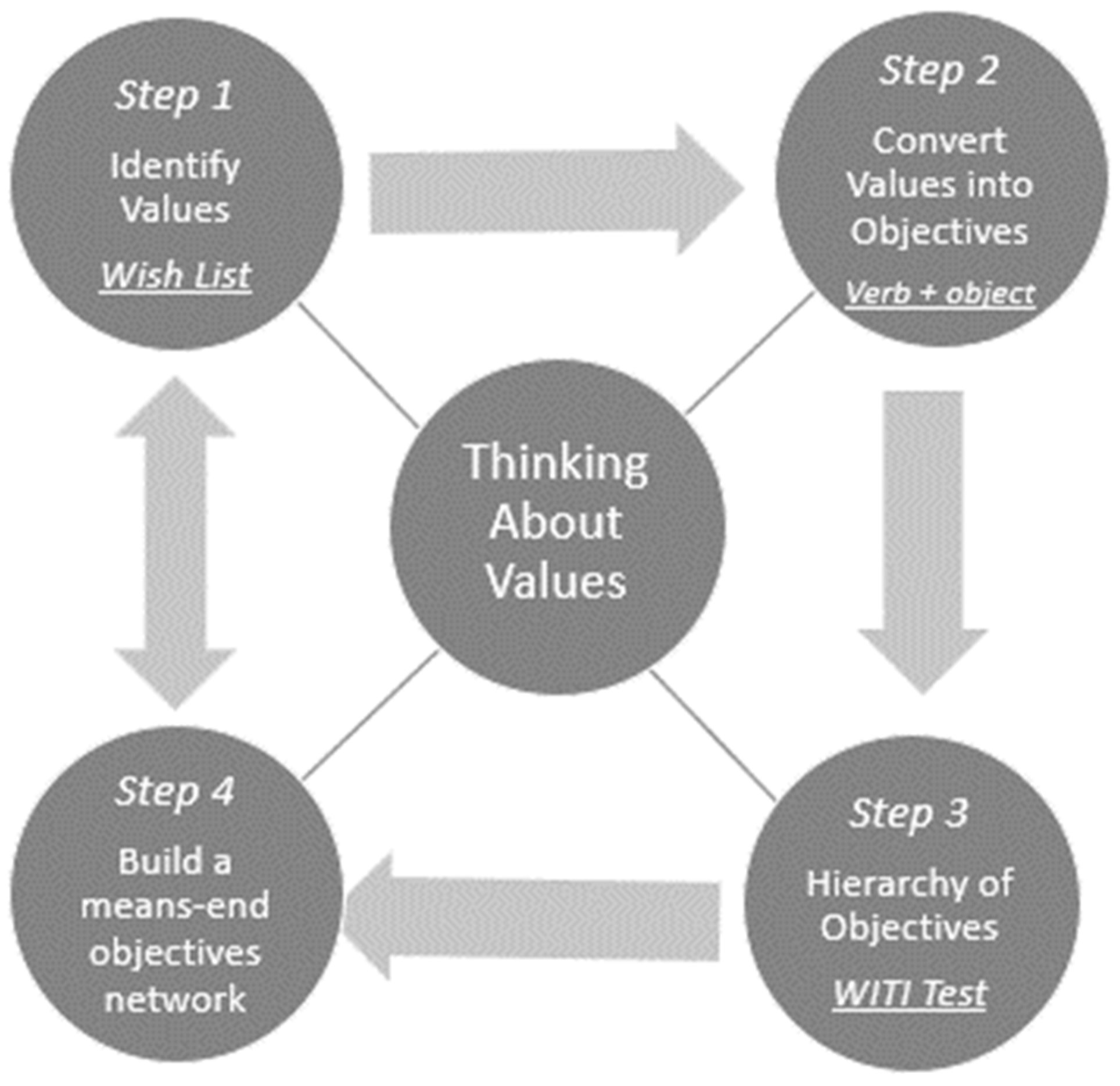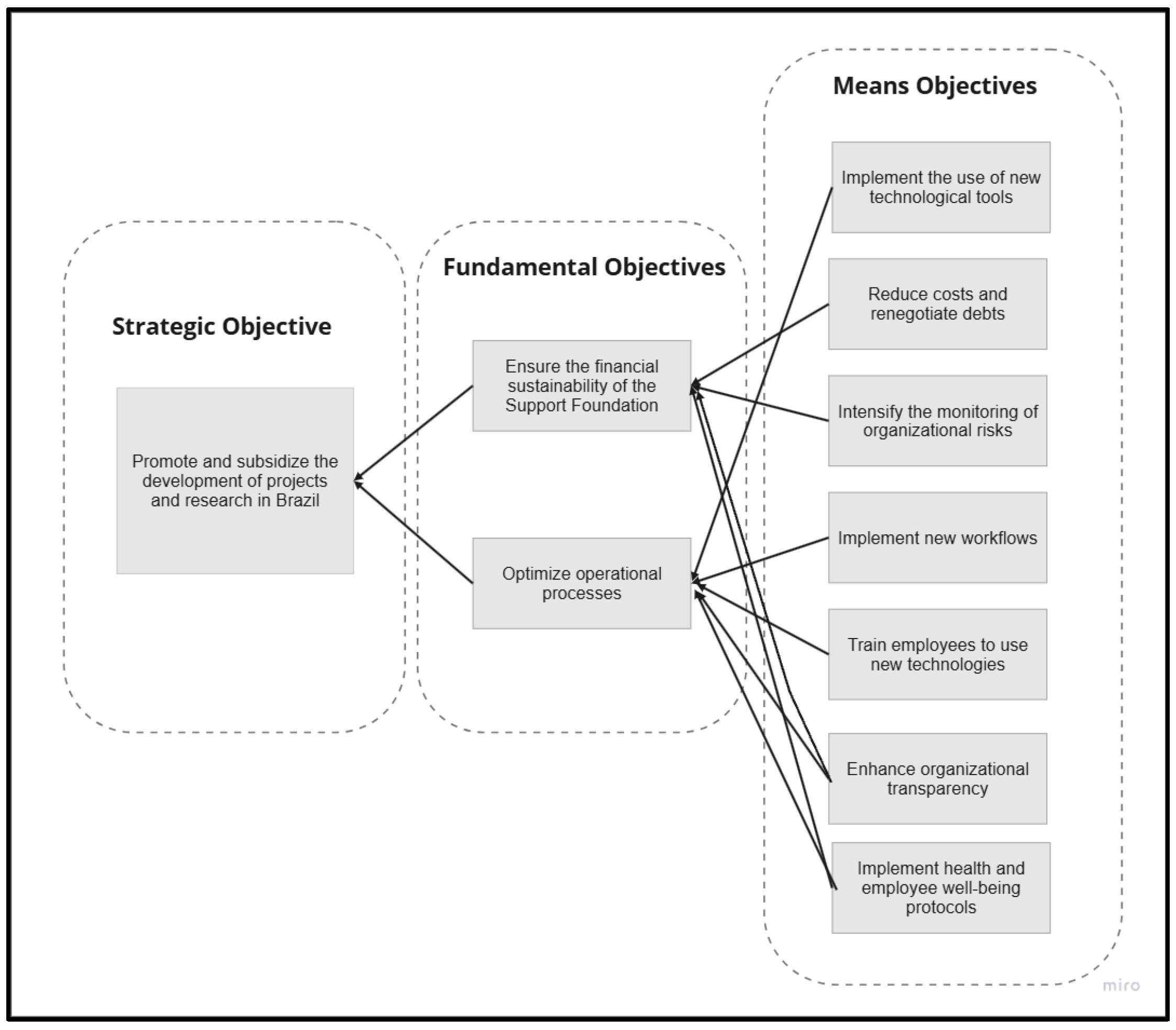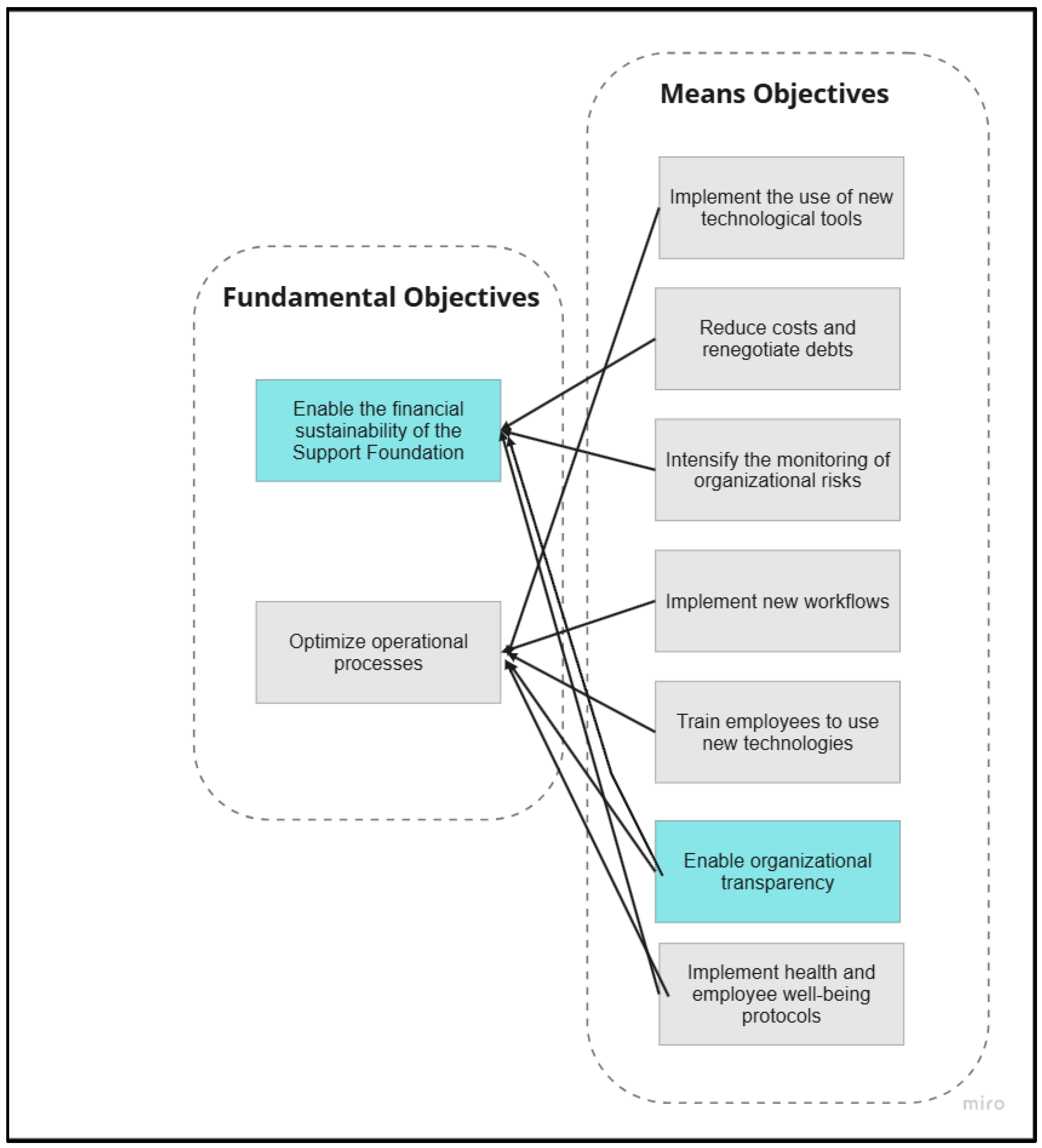Structuring Corporate Governance in the Context of Crisis: Lessons from the COVID-19 Pandemic in a Nonprofit Organization
Abstract
1. Introduction
2. Theoretical Framework
2.1. Corporate Governance
2.2. Support Foundation in Brazil
Corporate Governance in Support Foundations
2.3. Value-Focused Thinking (VFT)
3. Materials and Methods
3.1. Methodology
- To examine the values and objectives that guide the organization’s decisions in the process of adapting corporate governance practices;
- To analyze the feasibility of maintaining the new corporate governance management beyond the crisis context.
- What is the relationship between digital transformation and the management of corporate governance practices in the crisis context?
- What adaptations in governance practices were made by the organization under study to face the crisis caused by the 2020 pandemic?
- What were the main challenges faced by the organization in the process of adapting to the new corporate governance management?
- Which of the adaptations have the potential to be integrated into the organizational culture post-pandemic?
Limitations of the Study
3.2. Case Study
3.2.1. Organization Studied
3.2.2. Application of the VFT Method
- Stage 1: Initial decision framing;
- Stage 2: Process of identifying objectives;
- Stage 3: Consequence control;
- Stage 4: Identification of decision alternatives.
4. Results
4.1. Initial Framework of the Decision
- Ensure the financial sustainability of the organization;
- Ensure the safety, health and well-being of employees;
- Ensure the continuity and development of research;
- Promote innovation in operational processes.
- Decision Authority: The final decision-maker for the institution’s governance practices is the president;
- Client: Responsible for defining the requirements of what will be implemented. In the case of the support foundation, the client is the general secretary;
- Owner: Responsible for operationalizing the inputs for the decision-making process, ensuring its alignment and purpose. In the support foundation, the superintendents oversee all operations and strategic decisions;
- User: Responsible for implementing the decisions. In the foundation, the users are the project technicians and other operational staff;
- Consumer: Comprises all those who depend on the outcomes of the decisions, whether individuals or organizations. Thus, it includes the foundation itself, the affiliated Federal Higher Education Institution, Brazilian society, and the organizations (national and international) that are contracting, partnering, or funding the projects.
- Purpose: The decision to make adaptations to the corporate governance practices of the support foundation is driven by the need to ensure the financial sustainability of the organization in the context of the COVID-19 pandemic crisis;
- Perspective: This decision should be viewed as a strategic and multidimensional issue, as it involves innovative practices for the development of operational processes that impact the continuity of national and international research and projects;
- Scope: The actions within the scope of the problem involve the review of governance policies, the adoption of new strategies for resource mobilization, and the implementation of improvements and digital technologies.
- To decide on adaptations to the corporate governance practices of the Brazilian support foundation in the context of the COVID-19 pandemic, meeting operational requirements within budgetary, material, and personnel constraints, in order to ensure the institution’s long-term sustainability through compliance with the established plan.
4.2. Process of Identifying Objectives
4.3. Consequence Control
4.4. Identification of Decision Alternatives
- Make necessary budgetary adjustments;
- Expand the use of the cloud information system;
- Expand and intensify debt collection with the organization;
- Restructure operational areas to reduce costs;
- Select a new project management system;
- Acquire a new system for processing national and international purchases;
- Adapt the online portal for use by customers;
- Implement the activity monitoring and control system;
- Train employees on the new technological resources implemented;
- Monitor employee health and well-being with a program of periodic examinations and the implementation of sanitary measures in the workplace with increased remote work;
- Disclose organizational information transparently on the organization’s digital channels;
- Provide transparent project accountability;
- Acquire new IT equipment.
5. Discussion
6. Conclusions
Author Contributions
Funding
Institutional Review Board Statement
Informed Consent Statement
Data Availability Statement
Conflicts of Interest
References
- Al-lami, A., Shirkhodaie, M., & Safari, M. (2024). The digital transformation model for innovative marketing maturity in the oil companies. Revista de Gestão Social e Ambiental, 18(9), e06535. [Google Scholar] [CrossRef]
- Almeida, F., Rodrigues, H., & Freitas, P. (2024). “No Need to Dress to Impress” evidence on teleworking during and after the pandemic: A systematic review. Administrative Sciences, 14(4), 76. [Google Scholar] [CrossRef]
- Arik, M., Clark, L. A., & Raffo, D. M. (2016). Strategic responses of non-profit organizations to the economic crisis: Examining through the lenses of resource dependency and resourced-based view theories. Academy of Strategic Management Journal, 15(1), 48–70. [Google Scholar]
- Babeľová, Z. G., Vraňaková, N., & Stareček, A. (2022). Moderating effect of Industry 4.0 on the performance of enterprises in the constrains related to COVID-19 in the perception of employees in Slovakia. Administrative Sciences, 12(4), 183. [Google Scholar] [CrossRef]
- Belluzzo, R. C. B. (2019). Transformação digital e competência em informação: Reflexões sob o enfoque da Agenda 2030 e dos Objetivos de Desenvolvimento Sustentável. Revista Conhecimento Em Ação, 4, 3–30. [Google Scholar] [CrossRef]
- Bigioi, A. D., & Bigioi, C. E. (2023). Governance and performance in Romanian energy companies. Energies, 16(13), 5041. [Google Scholar] [CrossRef]
- BRASIL. (1994). Lei 8.958, de 20 de dezembro de 1994. In Diário oficial da união. Poder Executivo. Available online: https://www.planalto.gov.br/ccivil_03/leis/l8958.htm (accessed on 27 October 2024).
- Breque, M., De Nul, L., & Petridis, A. (2021). Industry 5.0 towards a sustainable, human-centric and resilient European industry. Available online: https://op.europa.eu/en/publication-detail/-/publication/468a892a-5097-11eb-b59f-01aa75ed71a1/language-en (accessed on 18 September 2024).
- Canito Filho, F. d. O., Tassigny, M. M., & de Almeida Bizarria, F. P. (2014). Possibilidades de efetivação de práticas de governança em fundações privadas. Revista Brasileira de Administração Científica, 5(3), 305–326. [Google Scholar] [CrossRef]
- Carreiro, N. K. D., Nascimento, J. C. H. B. D., Barbosa, F. L. S., Neto, A. R., & da Silva, M. C. (2021). Relações entre governança corporativa, desempenho financeiro e valor de mercado. Revista Facultad de Ciencias Económicas, 29(2), 11–28. [Google Scholar] [CrossRef]
- Chatzipetrou, E., & Varvaropoulos, K. (2024). Managerial digitalisation cost in the hotel sector: The case of northern Greece. Administrative Sciences, 14(3), 52. [Google Scholar] [CrossRef]
- Correia, L. F., & Amaral, H. F. (2006). Reflexão sobre as funções da governança corporativa. REGE Revista de Gestão, 13(1), 43–55. [Google Scholar]
- CVM, Comissão de Valores Mobiliário. (2019). Mercado de valores mobiliários Brasileiro (4th ed.). Comissão de Valores Mobiliários. [Google Scholar]
- Çipi, A., Fernandes, A. C. R. D., Ferreira, F. A. F., Ferreira, N. C. M. Q. F., & Meidutė-Kavaliauskienė, I. (2023). Detecting and developing new business opportunities in society 5.0 contexts: A sociotechnical approach. Technology in Society, 73, 102243. [Google Scholar] [CrossRef]
- FAURGS. (2021). Relatório de Gestão. Available online: https://www.faurgs.ufrgs.br/ (accessed on 2 November 2024).
- Ferreira, M. D., & Quelhas, O. L. G. (2007). Avaliação qualitativa das decisões do conselho de administração: O caso de uma instituição financeira. Revista Gestão Industrial, 3(3), 128–147. [Google Scholar] [CrossRef]
- Françozo, R. V., & Belderrain, M. C. N. (2022). A problem structuring method framework for value-focused thinking. EURO Journal on Decision Processes, 10, 100014. [Google Scholar] [CrossRef]
- Françozo, R. V., Paucar-Caceres, A., & Belderrain, M. C. N. (2022). Combining value-focused thinking and soft systems methodology: A systemic framework to structure the planning process at a special educational needs school in Brazil. Journal of the Operational Research Society, 73(5), 994–1013. [Google Scholar] [CrossRef]
- FUJB—Fundação Universitária José Bonifácio. (2021). Relatório Anual de Gestão. Available online: http://www.fujb.ufrj.br/PortalTransparencia/B)%20Relat%C3%B3rios%20Anuais%20de%20Gest%C3%A3o%20-%20Avalia%C3%A7%C3%A3o%20de%20Desempenho%20e%20Balan%C3%A7o%20Patrimonial/Anos/2021/Relatorio_Anual_de_Gestao_2021.pdf (accessed on 26 October 2024).
- FUJB—Fundação Universitária José Bonifácio. (2023). Relatório de Atividades. Available online: http://www.fujb.ufrj.br/PortalTransparencia/B)%20Relat%C3%B3rios%20Anuais%20de%20Gest%C3%A3o%20-%20Avalia%C3%A7%C3%A3o%20de%20Desempenho%20e%20Balan%C3%A7o%20Patrimonial/Anos/2023/Relatorio_de_Atividades_2023.pdf (accessed on 26 October 2024).
- Furstenau, L. B., Sott, M. K., Kipper, L. M., MacHado, E. L., Lopez-Robles, J. R., Dohan, M. S., Cobo, M. J., Zahid, A., Abbasi, Q. H., & Imran, M. A. (2020). Link between sustainability and Industry 4.0: Trends, challenges and new perspectives. IEEE Access, 8, 140079–140096. [Google Scholar] [CrossRef]
- Galanti, T., De Vincenzi, C., Buonomo, I., & Benevene, P. (2023). Digital transformation: Inevitable change or sizable opportunity? The strategic role of HR management in Industry 4.0. Administrative Sciences, 13(2), 30. [Google Scholar] [CrossRef]
- Ghobakhloo, M., Iranmanesh, M., Mubarak, M. F., Mubarik, M., Rejeb, A., & Nilashi, M. (2022). Identifying industry 5.0 contributions to sustainable development: A strategy roadmap for delivering sustainability values. Sustainable Production and Consumption, 33, 716–737. [Google Scholar] [CrossRef]
- Gil, A. C. (2008). Métodos e técnicas de pesquisa social. Atlas. [Google Scholar]
- Gollhardt, T., Halsbenning, S., Hermann, A., Karsakova, A., & Becker, J. (2020, June 22–24). Development of a digital transformation maturity model for IT companies. 2020 IEEE 22nd Conference on Business Informatics, CBI (Vol. 1, pp. 94–103), Antwerp, Belgium. [Google Scholar] [CrossRef]
- Golovianko, M., Terziyan, V., Branytskyi, V., & Malyk, D. (2023). Industry 4.0 vs. Industry 5.0: Co-existence, transition, or a hybrid. Procedia Computer Science, 217, 102–113. [Google Scholar] [CrossRef]
- Gökalp, E., & Martinez, V. (2021). Digital transformation capability maturity model enabling the assessment of industrial manufacturers. Computers in Industry, 132, 103522. [Google Scholar] [CrossRef]
- Gródek-Szostak, Z., Szeląg-Sikora, A., Siguencia, L. O., & Niemczyk, A. (2023). From Industry 4.0 paradigm towards Industry 5.0. Vide. Tehnologija. Resursi—Environment, Technology, Resources, 2, 46–49. [Google Scholar] [CrossRef]
- IBGC. (2023). Código das melhores práticas de governança corporativa (6th ed.). Instituto Brasileiro de Governança Corporativa. [Google Scholar]
- Keeney, R. L. (1992). Value-focused thinking: A path to creative decisionmaking. Harvard University Press. [Google Scholar]
- Keeney, R. L. (2008). Applying value-focused thinking. Military Operations Research, 13(2), 6–17. [Google Scholar] [CrossRef]
- Kim, M., & Mason, D. P. (2020). Are you ready: Financial management, operating reserves, and the immediate impact of COVID-19 on nonprofits. Nonprofit and Voluntary Sector Quarterly, 49(6), 1191–1209. [Google Scholar] [CrossRef]
- Martins, M., & Martins, V. F. (2013). Governança corporativa em uma fundação de serviços hospitalares: Um estudo de caso no Brasil. Revista de Administração de Roraima-RARR, 3(2), 70–89. [Google Scholar] [CrossRef][Green Version]
- Martins, V. A., Jeremias Junior, J., & Enciso, L. F. (2018). Conflitos de agência, governança corporativa e o serviço público brasileiro: Um ensaio teórico. RGC—Revista de Governança Corporativa, 5(1). [Google Scholar] [CrossRef]
- McMullin, C., & Raggo, P. (2020). Leadership and governance in times of crisis: A balancing act for nonprofit boards. Nonprofit and Voluntary Sector Quarterly, 49(6), 1182–1190. [Google Scholar] [CrossRef]
- Milani Filho, M. A. F., & Milani, A. M. M. (2011). Governança no terceiro setor: Estudo sobre uma organização francesa do século XIX. Revista Eletrônica de Ciência Administrativa, 10(1), 32–46. [Google Scholar] [CrossRef]
- Morais, D. C., Alencar, L. H., Paula, A., Costa, C. S., & Keeney, R. L. (2013). Using value-focused thinking in Brazil. Available online: www.scielo.br/pope (accessed on 26 October 2024).
- Noga, L., Ribeiro, F., & Gerigk, W. (2021). A relação entre o gerenciamento de resultados e os níveis de governança corporativa: Um estudo em empresas do segmento de energia elétrica da BM&FBOVESPA. Revista UNEMAT de Contabilidade, 10(19), 145–169. [Google Scholar]
- OCDE. (2024). Princípios de governação corporativa do G20/OCDE 2023. OECD Publishing. [Google Scholar] [CrossRef]
- Oliveira, R. R., Quelhas, O. L. G., & Bergiante, N. C. R. (2024a, October 31–November 1). Convergência entre as tecnologias digitais e o desenvolvimento sustentável: Análise em empresa de petróleo e gás com gestão ESG. XII Lean Six Sigma Congress—2024 & I Congresso de Excelência de Serviços Regulados, Rio de Janeiro, Brazil. [Google Scholar]
- Oliveira, R. R., Quelhas, O. L. G., & Bergiante, N. C. R. (2024b, September 26–27). Governança corporativa: Uma análise comparativa sob as perspectivas público e privada. XVIII CNEG_Congresso Nacional de Excelência Em Gestão & INOVARSE_Simpósio de Inovação e Responsabilidade Social, Rio de Janeiro, Brazil. [Google Scholar]
- Oliveira, R. R., Quelhas, O. L. G., de Pereira, D. A. M., & dos Santos, M. (2024c, November 5–6). Aplicação do método S.W.O.T-D.M.S no planejamento estratégico de transformação digital de uma organização de apoio à pesquisa e oo desenvolvimento. Simposio de Excelência em Gestão e Tecnologia—SEGet, Rio de Janeiro, Brazil. [Google Scholar]
- Passetti, E. E., Battaglia, M., Bianchi, L., & Annesi, N. (2021). Coping with the COVID-19 pandemic: The technical, moral and facilitating role of management control. Accounting, Auditing and Accountability Journal, 34(6), 1430–1444. [Google Scholar] [CrossRef]
- Peschl, A., & Schüth, N. J. (2022). Facing digital transformation with resilience—Operational measures to strengthen the openness towards change. Procedia Computer Science, 200, 1237–1243. [Google Scholar] [CrossRef]
- Ponte, V. M. R., Oliveira, M. C., De Luca, M. M. M., de Oliveira, O. V., Aragão, L. A., & de Sena, A. M. C. (2012). Motivações para a adoção de melhores práticas de governança corporativa segundo diretores de relações com investidores. BASE—Revista de Administração e Contabilidade Da Unisinos, 9(3), 255–269. [Google Scholar] [CrossRef]
- Puthusserry, P., King, T., Miller, K., & Khan, Z. (2022). A typology of emerging market SMEs’ COVID-19 response strategies: The role of TMTs and organizational design. British Journal of Management, 33(2), 603–633. [Google Scholar] [CrossRef]
- Ramos, C. M. Q. (2021). Digital transformation: Effects on education, trade and environmental sustainability. In RISTI—Revista iberica de sistemas e tecnologias de informacao (Vol. 2021, Issue 44, pp. 1–4). Associacao Iberica de Sistemas e Tecnologias de Informacao. [Google Scholar] [CrossRef]
- Riccotta, R., & Costa, I. (2022). O impacto da transformação digital na sustentabilidade e a gestão do conhecimento em uma empresa de manufatura: Um estudo de caso. Perspectivas Em Gestão & Conhecimento, 12, 66–85. [Google Scholar] [CrossRef]
- Rodrigues, A. L., & Malo, M. C. (2006). Estruturas de governança e empreendedorismo coletivo: O caso dos doutores da alegria. Revista de Administração Contemporânea, 10, 29–50. [Google Scholar] [CrossRef]
- Rojko, K., Erman, N., & Jelovac, D. (2020). Impacts of the transformation to Industry 4.0 in the manufacturing sector: The case of the U.S. Organizacija, 53(4), 287–305. [Google Scholar] [CrossRef]
- Saharti, M., Chaudhry, S. M., Pekar, V., & Bajoori, E. (2024). Environmental, social and governance (ESG) performance of firms in the era of geopolitical conflicts. Journal of Environmental Management, 351, 119744. [Google Scholar] [CrossRef]
- Santhi, A. R., & Muthuswamy, P. (2023). Industry 5.0 or industry 4.0S? Introduction to industry 4.0 and a peek into the prospective industry 5.0 technologies. International Journal on Interactive Design and Manufacturing, 17(2), 947–979. [Google Scholar] [CrossRef]
- Serafim, E., Luiz, O., & Quelhas, G. (2010). Governança corporativa-contribuições de boas práticas para o desempenho das organizações. Available online: www.ethos.org.br (accessed on 29 October 2024).
- Silva Junior, A., da Silva, V. C., Dumer, M. C. R., & de Oliveira Martins-Silva, P. (2021). Modelos de governança corporativa e indicadores econômico-financeiros de Instituições de Educação Superior privadas: Uma análise do mercado de capitais brasileiro. Avaliação: Revista Da Avaliação Da Educação Superior (Campinas), 26(2), 629–653. [Google Scholar] [CrossRef]
- Tang, C., Dong, S., & Zhou, R. (2025). The impact of digitalization on corporate resilience. International Review of Economics & Finance, 97, 103834. [Google Scholar] [CrossRef]
- Velte, P. (2023). The link between corporate governance and corporate financial misconduct. A review of archival studies and implications for future research. Management Review Quarterly, 73(1), 353–411. [Google Scholar] [CrossRef]
- Vieira, G. B., Logullo De Souza, Y., Simões, A., Araújo De Almeida, J., Carmen, M., & Belderrain, N. (2023a). Using value-focused thinking in an integrated process to support decisions. Pesquisa Operacional, 44, e276110. [Google Scholar] [CrossRef]
- Vieira, G. B., Souza, Y. L., Simões, A., de Almeida, J. A., & Belderrain, M. C. N. (2023b). Identifying initiatives for solid waste collection using VFT as a PSM. Available online: https://proceedings.science/sbpo/sbpo-2023/trabalhos/selecting-initiatives-for-solidwaste-collection-using-vft-as-a-psm?lang=pt-br (accessed on 4 November 2024).
- Villiers, C., & Dimes, R. (2021). Determinants, mechanisms and consequences of corporate governance reporting: A research framework. Journal of Management and Governance, 25(1), 7–26. [Google Scholar] [CrossRef]
- Waniak-Michalak, H., Leitoniene, S., & Perica, I. (2024). To survive in the COVID-19 Pandemic: The financial aspects of NGOs. Contemporary Economics, 18(3), 321–335. [Google Scholar] [CrossRef]
- Yin, R. K. (2015). Estudo de caso: Planejamento e métodos (5th ed.). Bookman. [Google Scholar]
- Zeng, X., & Rojniruttikul, N. (2025). The impact of the forward-looking strategy on the sustainable development of enterprises under the background of digital economy—Based on dynamic regulation. Sustainability, 17(1), 272. [Google Scholar] [CrossRef]
- Zhang, C., Chen, P., & Hao, Y. (2022). The impact of digital transformation on corporate sustainability-new evidence from Chinese listed companies. Frontiers in Environmental Science, 10, 1047418. [Google Scholar] [CrossRef]
- Zhang, J., Long, J., & von Schaewen, A. M. E. (2021). How does digital transformation improve organizational resilience?—Findings from pls-sem and fsqca. Sustainability, 13(20), 11487. [Google Scholar] [CrossRef]
- Zhironkin, S., Gasanov, M., & Suslova, Y. (2022). Orderliness in mining 4.0. Energies, 15(21), 8153. [Google Scholar] [CrossRef]




Disclaimer/Publisher’s Note: The statements, opinions and data contained in all publications are solely those of the individual author(s) and contributor(s) and not of MDPI and/or the editor(s). MDPI and/or the editor(s) disclaim responsibility for any injury to people or property resulting from any ideas, methods, instructions or products referred to in the content. |
© 2025 by the authors. Licensee MDPI, Basel, Switzerland. This article is an open access article distributed under the terms and conditions of the Creative Commons Attribution (CC BY) license (https://creativecommons.org/licenses/by/4.0/).
Share and Cite
Oliveira, R.R.d.; Quelhas, O.L.G.; Bergiante, N.C.R. Structuring Corporate Governance in the Context of Crisis: Lessons from the COVID-19 Pandemic in a Nonprofit Organization. Adm. Sci. 2025, 15, 91. https://doi.org/10.3390/admsci15030091
Oliveira RRd, Quelhas OLG, Bergiante NCR. Structuring Corporate Governance in the Context of Crisis: Lessons from the COVID-19 Pandemic in a Nonprofit Organization. Administrative Sciences. 2025; 15(3):91. https://doi.org/10.3390/admsci15030091
Chicago/Turabian StyleOliveira, Raffaella Regueira de, Osvaldo Luiz Gonçalves Quelhas, and Níssia Carvalho Rosa Bergiante. 2025. "Structuring Corporate Governance in the Context of Crisis: Lessons from the COVID-19 Pandemic in a Nonprofit Organization" Administrative Sciences 15, no. 3: 91. https://doi.org/10.3390/admsci15030091
APA StyleOliveira, R. R. d., Quelhas, O. L. G., & Bergiante, N. C. R. (2025). Structuring Corporate Governance in the Context of Crisis: Lessons from the COVID-19 Pandemic in a Nonprofit Organization. Administrative Sciences, 15(3), 91. https://doi.org/10.3390/admsci15030091






